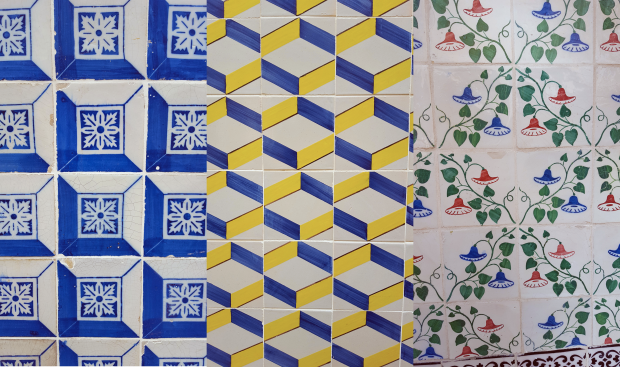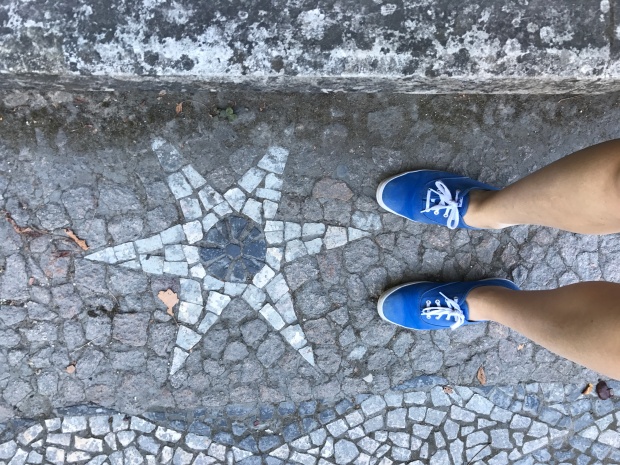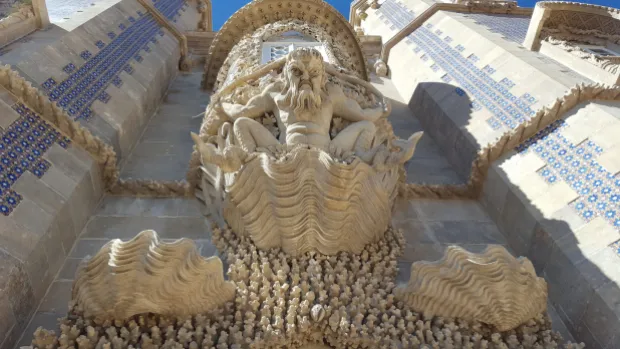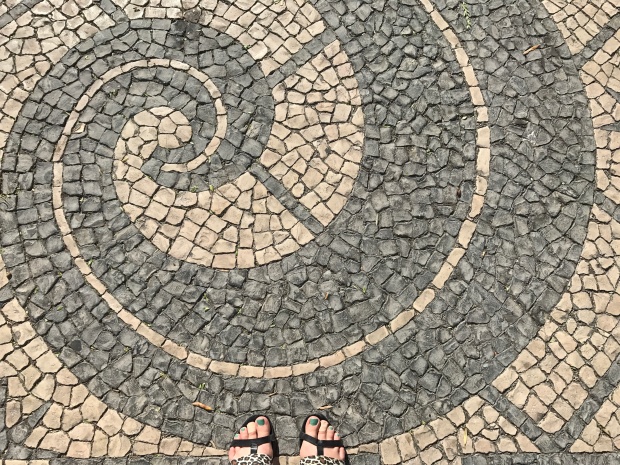
Azulejos and calçadas: The story behind Portugal’s tile art
Here in the U.S., our cities have transportation departments, building commissioners and art endowments–three separate but equally important entities. But in beautiful Portugal, things work a little differently…because the roads and buildings are art.

I’d read extensively about the azulejos we’d see in Portugal, but I thought I’d only see tile work on a few major churches and monuments. I also thought, as the “azul” in azulejo seemed to indicate, that they’d all be blue and white. Instead, what I found was a multicolored visual feast around every corner, whether I looked down at my feet or three stories above me.
Tile decorations and mosaic designs are simply inescapable in Portugal–and thank goodness for that, because there’s no more satisfying diversion from a long day of walking than stopping to inspect a breathtaking mural on the side of a confeitaria or looking down at your feet to discover an intricate flower pattern on the sidewalk. It’s clear that the country’s handiwork with ceramic tiles, basalt and limestone is what really separates it visually from the rest of Western Europe.
From the moment we arrived in Lisbon, we saw tiles everywhere. They fit together in elaborate, hand-painted murals narrating Lisbon’s maritime history in the city’s metro stations. They adorned the face of seemingly every building from the northern wine country all the way down to the sun-drenched, beachy Algarve. Tiny black and white stones fit together to form the whole country’s sidewalks. They were by turns weather-worn, ornate, beautiful, ugly, geometric, slippery and three-dimensional. Portugal didn’t seem to discriminate. Rather, it seemed to say, “If it’s covered in tiles, any tiles, it’s Portuguese.”

After a while, I wondered why tile art was so pervasive in Portugal but nowhere else in Europe…so I did some research. It turns out the Portuguese term for tiles, azulejos, has nothing to do with azul, the word for blue, like I thought. Instead, it’s actually derived from the Arabic word al-zulayj, which means “polished stone.” Whoever named them must have been paying respect to Egypt, the birthplace of tiles. But despite Portugal’s deep connection with Northern Africa–Moors controlled the Iberian peninsula for 700 years until Catholic conquerors wrested the land away in 1492–the tiles we see today were mostly inspired by the Alhambra in Spain. Legend has it that the king, Dom Manuel I, saw those wondrous Moorish tiles In Granada and used them as inspiration when designing his palace in Évora. All his tiles were imported from Seville and featured nothing more than abstract geometric patterns, in keeping with an Islamic law that condemns idolatry.
Dom Manuel I made tiny Portugal a conqueror of far-flung lands and a major global power, and for that he was revered. The clergy and the nobility hastened to follow his artistic example. In an architectural style they dubbed Manueline, they built churches, government seats and private estates with nods to his influence–intricate designs carved out of limestone, maritime symbols…and, of course, tiles. It wasn’t long until tile fever took over.

The history of Portugal’s calçadas, or tiled sidewalks, is less documented–perhaps because, unlike azulejos, there isn’t an entire museum devoted to them! We know the first intricate mosaics in Portugal were designed by the Romans 2,000 years ago–in fact, you can still ooh and aah at them today at an archaeological site just outside Coimbra. But they never would have returned were it not for Dom Joao II, who in 1498 issued a decree that Portugal’s dirt roads were to be paved with limestone. (It’s said that he did this not for the good of the people but so that he could march in a dirt-free street parade in his honor…alongside a white rhino. You can’t make this stuff up!)
That takes us to 1755, the year of the earthquake that so devastated Lisbon that almost no building in the city survived. In a hasty attempt to rebuild, road workers gathered together the shards of limestone and basalt that once graced Lisbon’s roads and formed its handsome buildings and turned them into mosaic sidewalks, taking inspiration from their Roman ancestors.

The technique, once a necessity, transformed into an art and spread all over the country in the mid-19th century. Even Portugal’s former colonies boast artistic calçadas, from delicate geometric patterns in Maputo, Mozambique, to a giant wave-patterned esplanade at Copacabana Beach in Rio de Janeiro.
If you travel all over Portugal, pay close attention to the sidewalks and sides of buildings: They’ll often tell you a lot about the local heritage. Travel to Pinhão, a town sitting on the banks of the Douro River, and you’ll see its history of grape-growing and wine-making told in tile murals at the train station. Look down while you’re walking around Lagos and you’ll see mosaics in the shape of crabs, fish and octopuses, a testament to the Algarve region’s strong fishing industry and close connection to the ocean. In Sintra the sidewalk mosaics are star-shaped, a nod to the fact that the town name means “bright star” in a now-defunct Indo-European language.

If you visit Portugal, don’t forget to pad your itinerary with lots of “Wait, I need another look at this amazing tile/mosaic!” time. With all the steep hills you’ll be climbing, you’ll need a break anyway.








Comments
Paige W
March 8, 2017 at 1:22 am
I’ve been dying to get to Portugal! It always just looks so stunning. I’ve not seen a lot about the tiles, though, it’s a totally unique form of street art.
BeckyB
November 20, 2017 at 8:30 am
It’s a wonderful country and the azulejos are amazing.
Tips on traveling to Portugal – Jill Kimball
April 15, 2017 at 5:05 pm
[…] make sure to wear comfortable, cushioned shoes and be careful on rainy days…those tiled sidewalks can be mighty […]
A relaxing weekend in the Eastern Algarve – Jill Kimball
September 1, 2017 at 3:24 am
[…] but it’s not much more than a few ruined walls these days, thanks to the 1755 earthquake that also wiped out Lisbon. There’s not much of the castle itself to see, but the view from the top can’t be beat, […]
Recent work – Jill Kimball
February 26, 2020 at 5:59 pm
[…] Azulejos and calçadas: The story behind Portugal’s tile art […]
Comments are closed